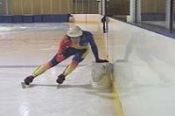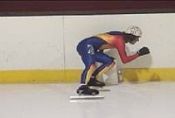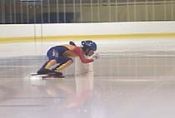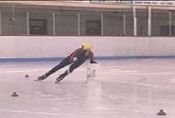Bucket Drills
By Susan Ellis, December 2003
Bucket drills are one of the most useful tools in learning the lean, pressure, and movement of weight on the corners. You can buy them at some hardware stores or get them from restaurants as food is often shipped in buckets. A five gallon bucket works best.
Before starting the moving bucket drills do a check of the ice surface to make sure there are no bumps or holes that the bucket may get caught on, or you may find yourself sprawling on the ice. Either remove the handle or turn the handle away from your skates so you don’t trip on it.
It may help to practice some of the static bucket drills off ice first with your skates on to get the feel of leaning on the bucket in skates.
Because you are not in motion on the static drills, the position is very difficult to hold in terms of both stability and strength. It may help to have someone hold the bucket so it doesn’t scoot away from you, as well as hold your skates in place so they don’t slide backwards.
Although it is not the recommended method, if you are having difficulty supporting yourself using just the left arm, you may reach across and put the right hand on the bucket as well, but make sure you don’t rotate while doing this. If you feel you need to use two hands in the beginning, I strongly recommend that you make every attempt to move to one hand as soon as possible.
Before starting the moving bucket drills do a check of the ice surface to make sure there are no bumps or holes that the bucket may get caught on, or you may find yourself sprawling on the ice. Either remove the handle or turn the handle away from your skates so you don’t trip on it.
It may help to practice some of the static bucket drills off ice first with your skates on to get the feel of leaning on the bucket in skates.
Because you are not in motion on the static drills, the position is very difficult to hold in terms of both stability and strength. It may help to have someone hold the bucket so it doesn’t scoot away from you, as well as hold your skates in place so they don’t slide backwards.
Although it is not the recommended method, if you are having difficulty supporting yourself using just the left arm, you may reach across and put the right hand on the bucket as well, but make sure you don’t rotate while doing this. If you feel you need to use two hands in the beginning, I strongly recommend that you make every attempt to move to one hand as soon as possible.

LEFT LEG STATIC LEAN – BOARDS
Objective:
Method:
Objective:
- To create stability around the ankle joint by closing to the strongest angle.
- To create maximum pressure under the outside part of the ball of the left foot.
- To feel the lean of the entire body in to the corner in the most compact position.
- To experience compression of the ankle joint to the power position.
- To feel the shift of weight to the point of instability.
Method:
- Place a 5 gallon bucket upside down against the boards. Stand to the right side, and slightly behind the bucket about an arm’s length away. Your feet should be about shoulder width apart and pointing straight ahead, parallel to the boards. The upper body should be bent at the waist so the back is in a low position, relaxed, with the back and shoulders slightly rounded and the butt tucked.
- Now slowly bend the ankles so that the knees advance forward and down over the toes. At the same time the hips descend to reduce the knee angle to about 90-100 degrees. Keep pressing the knees forward and down until you cannot bend the ankle any further, the angle is closed as much as possible, and you feel pressure under the ball of the foot.
- Place your left hand flat on the top of the bucket with the fingers parallel to the boards. Lean the entire body towards the bucket. As you lean, your left elbow bends so you are leaning to the point where your left shoulder is just above your hand on the bucket. Ensure that as you lean, the weight stays on the ball of the foot. The tendency is for the weight to drift backwards on this drill. The only way to keep it forward is to ensure maximum compression of the ankle and keep the upper body low and compact.
- Extend the right leg directly to the side and lift it about 2 inches off the ice. Keep the right foot in line with the left foot and pointing straight ahead. Hold this position for about 5 seconds while you check the technical points in your position. Note: This is a hard position to hold as you are really working the hip extensors on the right side. As you get more used to the drill try holding the position for up to 30 seconds at a time to improve your strength.

Technical points:
Feelings associated with the movement:
- The blades remain parallel and pointing straight ahead. There may be a tendency for the left blade to rotate outward in this drill. If you have maximum pressure under the ball of the foot this should not happen. You must also keep the right skate even with the left skate. If the right skate drifts back you will find yourself on your heels, and soon thereafter, on your butt on the ice.
- With the left knee as far forward as possible you should not be able to see your toes.
- The upper body is relaxed, with the back and shoulders slightly rounded and the butt tucked.
- The left knee bent to 90-100 degrees.
- The right leg is straight and extended directly to the side.
- Your shoulders and hips must not rotate at any time. They remain perpendicular to the boards.
- Your left and right hips are both to the inside of your left foot.
- You are leaning on the left edge of your left skate.
- Be sure there is no collapsing of the ankle to the inside. The ankle should only bend in a forward direction.
- The right arm is in a forward arm swing position in front of you.
- There should be a straight line from the left ankle to the left knee to the left hip to the left shoulder. Any break in the line means you may have rotated or twisted, or simply haven’t leaned the whole body enough.
Feelings associated with the movement:
- The left ankle feels compressed, locked and strong in the power position. There is a tightness around the ankle joint.
- When the left ankle is bent as far forward as possible you feel pressure under the outside part of the ball of the foot.
- As you drop the left knee forward and down, and the knee bends to 90-100 degrees, you feel the left hip sink forward and in toward the boards and a slight stretching of the hip muscles. (Be careful not to rotate the hip as you drop down. The hips must keep the same alignment as you drop down as they had in the up position).
- You feel the body is compact, such that there is very little space between the belly button and the left thigh.
- You are leaning to the point of instability, so that you feel if you were to remove your hand from the boards your body would fall forwards as well as towards the boards, on about a 45 degree angle.

LEFT LEG BUCKET DRILL IN MOTION
Now that you have the feeling for leaning on the bucket, it’s time to do it in motion.
Method:
Now that you have the feeling for leaning on the bucket, it’s time to do it in motion.
Method:
- Place a 5 gallon bucket upside down to the left side, and slightly ahead of your body, and place your left hand on the top of the bucket with the fingers pointing straight ahead.
- Skate one lap inside the track in the low position, going close to the blocks, to get up to at least 60% speed. The drill won’t work if you are going too slow as the friction of the bucket slows you down when you stop skating to glide.
- When you have enough speed to carry you through the entire corner on the inside of the track stop skating at about the blue line just before the corner. Lean the entire body towards the bucket. As you lean your left elbow bends so you are leaning to the point where your left shoulder is just above your hand on the bucket. Ensure that, as you lean, the weight shifts forward from the middle part of the blade to the ball of the foot by compressing the ankle and compacting the entire body. The tendency is for the weight to drift backwards on this drill. The only way to keep it forward is to ensure maximum compression of the ankle and keep the upper body low and compact.

- While leaning with all the pressure on the ball of the foot of left skate, and maintaining the compact position, extend the right leg directly to the side about 2 inches off the ice.
- Hold this static position as you glide the entire turn all the way past the last block.
- Skate the straight to get your speed up for the next corner and repeat the drill.
Review the Technical Points and Feelings Associated with the Static Drill against the boards as the same will apply to the In Motion Drill.
